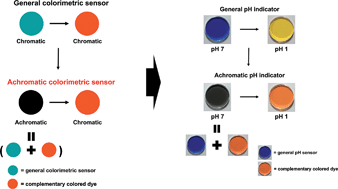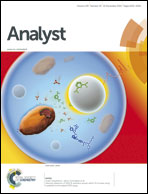Achromatic–chromatic colorimetric sensors for on–off type detection of analytes†
Abstract
We report the development of achromatic colorimetric sensors; sensors changing their colors from achromatic black to other chromatic colors. An achromatic colorimetric sensor was prepared by mixing a general colorimetric indicator, whose color changes between chromatic colors, and a complementary colored dye with no reaction to the targeted analyte. As the color of an achromatic colorimetric sensor changes from black to a chromatic color, the color change could be much easily recognized than general colorimetric sensors with naked eyes. More importantly, the achromatic colorimetric sensors enable on–off type recognition of the presence of analytes, which have not been achieved from most colorimetric sensors. In addition, the color changes from some achromatic colorimetric sensors (achromatic Eriochrome Black T and achromatic Benedict's solution) could be recognized with naked eyes at much lower concentration ranges than normal chromatic colorimetric sensors. These results provide new opportunities in the use of colorimetric sensors for diverse applications, such as harsh industrial, environmental, and biological detection.


 Please wait while we load your content...
Please wait while we load your content...